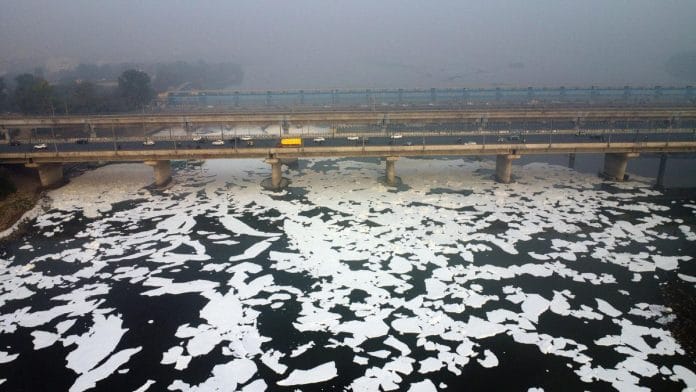New Delhi: Fifty-seven-year-old Devendra Singh cycles past the Najafgarh drain every day, the stench assailing his nostrils and the mounds of trash his eyes. This toxic water flows into Delhi’s Yamuna, further poisoning an already dying river.
The drain wasn’t always like this. It was clean once, and there was hope it could be clean again. But that hope is ebbing as a major Yamuna clean-up project grinds to a halt in a fight for credit between Delhi’s Lieutenant Governor and the Aam Aadmi Party government. While the BJP, Congress, and AAP have made the Yamuna a centrepiece of their campaigns in the Delhi elections, the river itself continues to decay.
“This drain was once the Sahibi River. The water was clean, and in my childhood, we would use it for our daily needs. Government neglect has reduced this river to a nallah (drain),” Singh said.
The Najafgarh drain accounts for 68.71 per cent of Delhi’s wastewater being discharged into the Yamuna, making it one of the biggest contributors to the river’s toxic load. For decades, promises of revival have come and gone, leaving the frothing, chemical-streaked waters as a reminder of systemic neglect and failure. And it’s not just a Delhi or Yamuna problem.
Across India, rivers once central to urban life are being abandoned and neglected, with no clear path to recovery. In Mumbai, the Mithi River has suffered a similar fate, starring in political campaigns but turning into a sewage channel due to unchecked urbanisation and agency conflicts. It’s much the same with the Cooum River in Chennai. Despite pumping in Rs 3,000 crore in 2012 for its cleaning and then another Rs 735 crore for its restoration since 2015, it’s still degrading into a thin sewer line.
Meanwhile, Delhi Lieutenant Governor VK Saxena inaugurated a park called Yamuna Vatika on the river’s western bank earlier this month, describing it as “yet another initiative to reclaim the river’s ecological richness” and part of “continuous efforts” to restore it. However, the last large-scale plan to rejuvenate the Yamuna hangs in limbo.
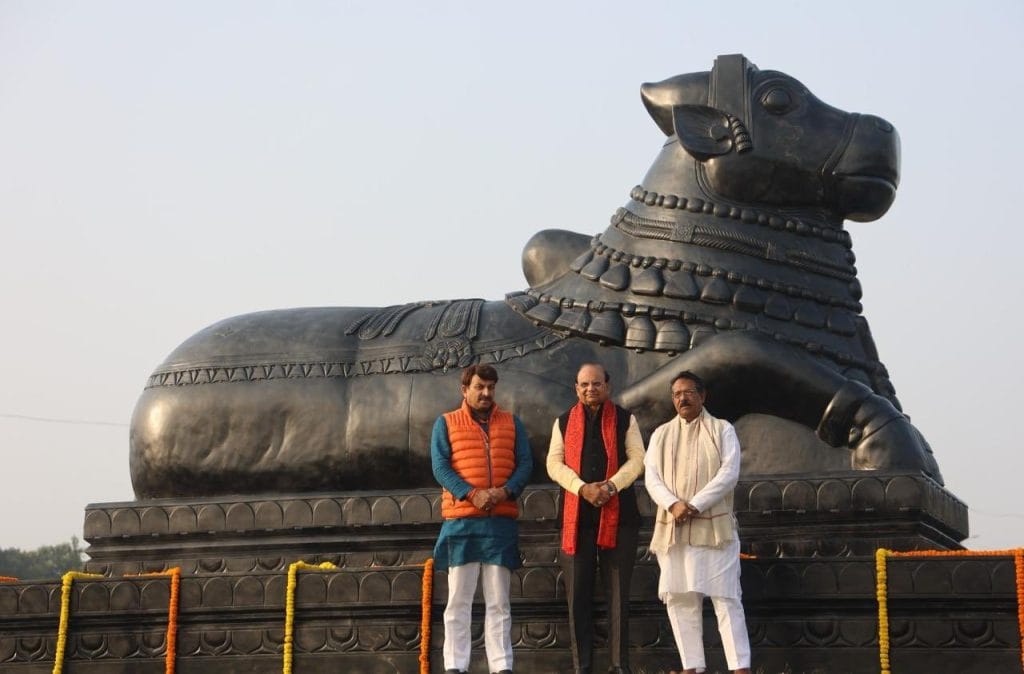
The Yamuna’s most recent travails began in January 2023 when the National Green Tribunal appointed a high-level committee to oversee the cleaning of the river, giving it a timeline of six months to show visible results. LG VK Saxena was appointed as the head of the committee tasked with overseeing progress.
The plan included desilting the Najafgarh drain, unclogging its passages, and improving the biochemical oxygen demand (BOD) levels—a key indicator of the health of a water body. Teams also started physically removing trash from the drain’s banks. It was all widely applauded, but, ironically, this became one of the reasons the project stalled.
Just months into the project, the AAP government moved the Supreme Court, challenging LG’s authority to lead this committee. It also accused the LG-led committee of taking credit for work already initiated by the Delhi government, claiming “no new projects” were being implemented under the project. The Yamuna rejuvenation plan sputtered to a halt and the Najafgarh drain is back to its original state—filthy, stinking, and abandoned.
And residents are helpless spectators watching agencies pass the buck.
“The Najafgarh drain is a victim of multiple owners. No one wants to take responsibility, but no one wants to abandon ownership,” said Diwan Singh, a Delhi-based environmental activist advocating for a comprehensive revival plan for the Najafgarh drain. “Concrete action can only be expected when agencies work together. But that doesn’t seem to be happening.”
Also Read: What’s making Delhi air deadlier
Legal battle
In March 2023, earthmovers rumbled to life along the Najafgarh drain, pulling out heaps of plastic and sludge. Government teams combed through the filth, and local residents gathered to watch, hopeful that the long-polluted drain might finally be cleaned and the neighbourhoods around it made more liveable. But the enthusiasm did not last long.
“Some smaller desilting machines were parked here for months after the work stopped, so we had our hopes alive. But when the SC stayed the NGT’s appointment, we knew this was like all the earlier announcements,” said Sooraj Kumar, a 29-year-old resident of Najafgarh’s Ghummenhera village and an environmental activist who has been championing the Yamuna’s cleaning.
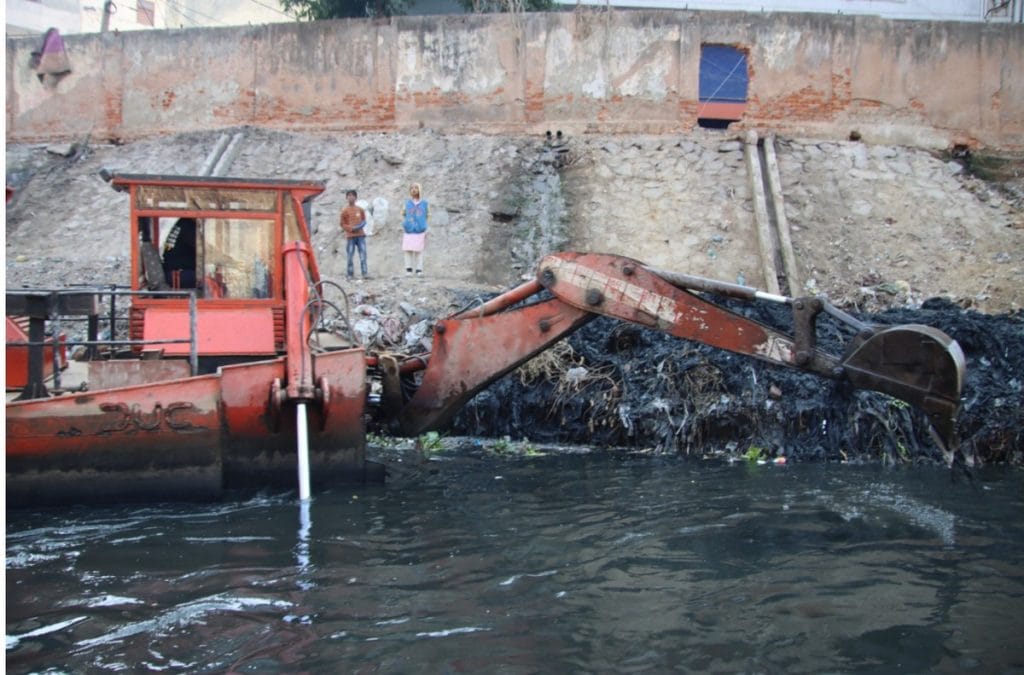
The trouble began when the Lieutenant Governor-led committee on Yamuna pollution started sharing its progress updates. In a June 2023 press statement, the LG’s office claimed a 33 per cent decline in biochemical oxygen demand (BOD) levels in the Najafgarh drain compared to the previous year.
The Delhi government promptly refuted this claim.
Senior AAP leader and then water minister Saurabh Bharadwaj accused Saxena of wrongfully claiming credit for the Yamuna cleaning initiatives led by the Delhi government.
“The progress made in the cleaning of Yamuna was a result of Chief Minister Arvind Kejriwal’s six-point action plan, which he announced in 2021,” Bharadwaj said in a press briefing.
He also argued that the LG had no financial authority to approve projects under the Delhi Jal Board (DJB) and the Irrigation and Flood Control Department, which are responsible for the Yamuna and its floodplains.
By this time, the AAP government had already moved the Supreme Court challenging LG’s appointment as the head of the NGT high-level committee. It alleged that the NGT’s decision sidelined the administration by appointing an “unelected figurehead who does not have any authority to act on his own except on the aid and advice of the elected Delhi government.”
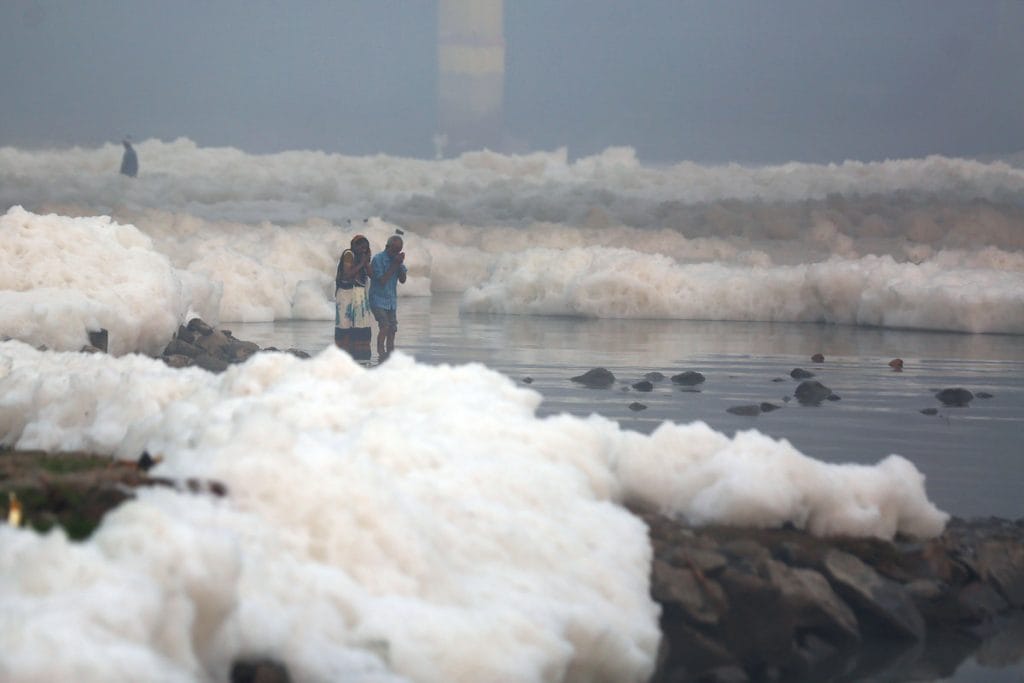
In July 2023, the Supreme Court stayed the NGT’s order, effectively halting the committee’s work.
“We do not care who takes up the cleaning project. We just want Yamuna to be cleaned, which cannot happen unless efforts are made to clean up the source,” Kumar said.
AAP leaders, however, insist that they were only trying to rectify an injustice. A party spokesperson told ThePrint on condition of anonymity that the LG-headed committee was only “repackaging” the work already being done on the ground.
“We have been connecting the slum clusters to the sewer lines, setting up sewage treatment plants, and desilting trunk sewer lines. We cannot deny that there was some level of influence in the LG in getting appointed as the head of the NGT committee,” he added.
While the LG office did not appeal against the stay, Saxena vehemently hit out at the AAP government for derailing the Yamuna rejuvenation project.
In a series of posts on X in November 2023, he said that the Yamuna floodplains had turned into a “dump yard” and “open toilet”.
“Year after year, one promise after another, froth and effluents remain unchecked,” Saxena posted.
He pointed to cleaner floodplains, improved sewage treatment, and land for new STPs “and a resultant slight improvement in water quality “ before accusing the Delhi government of obstructing efforts by securing a Supreme Court stay on the NGT order.
Officials from Raj Niwas echoed these claims, contending that Saxena’s appointment was logical due to his oversight of multiple agencies involved in the upkeep of the Yamuna.
“There are central agencies like the Central Water Commission and the Central Pollution Control Board, over which the LG has some authority,” said an official from the LG’s office. “The DDA (Delhi Development Authority) is directly under the LG, and state departments like the DJB, Municipal Corporation of Delhi, and Irrigation and Flood Control Department are also answerable to him. It only made sense for an overarching figure to head the committee.”
In an official document published in July 2023, the LG office claimed that in six months, between January and June 2023, 17 km of the Yamuna and 32 subsidiary drains of the Najafgarh drain were desilted.
The reduction of BOD is a sign of the self-healing power of the river and the drain,” the document read.
The dying river
Raju Maithal, a 24-year-old fisherman, steers his boat through the murky waters along the south bank of the Yamuna. He calls this the cleaner part of the river, even though just metres away, white toxic foam coats the water, killing any aquatic life.
“Earlier, a lot more of the river was open to fishermen like me,” Maithal said. “But pollution has spiked in recent years, and so has the struggle for people like us who depend on the river for our livelihoods.”
In November 2024, a water quality report submitted to the NGT by the Delhi Pollution Control Committee noted that faecal coliform levels in the Yamuna had hit an MPN (most probable number) of 7.9 million units per 100 ml at Asgarpur, where the river exits Delhi.
This was the highest concentration recorded since December 2020, when it reached 1.2 billion units per 100 ml.
MPN is a common tool for assessing water quality and is often used to detect coliforms and E. coli.
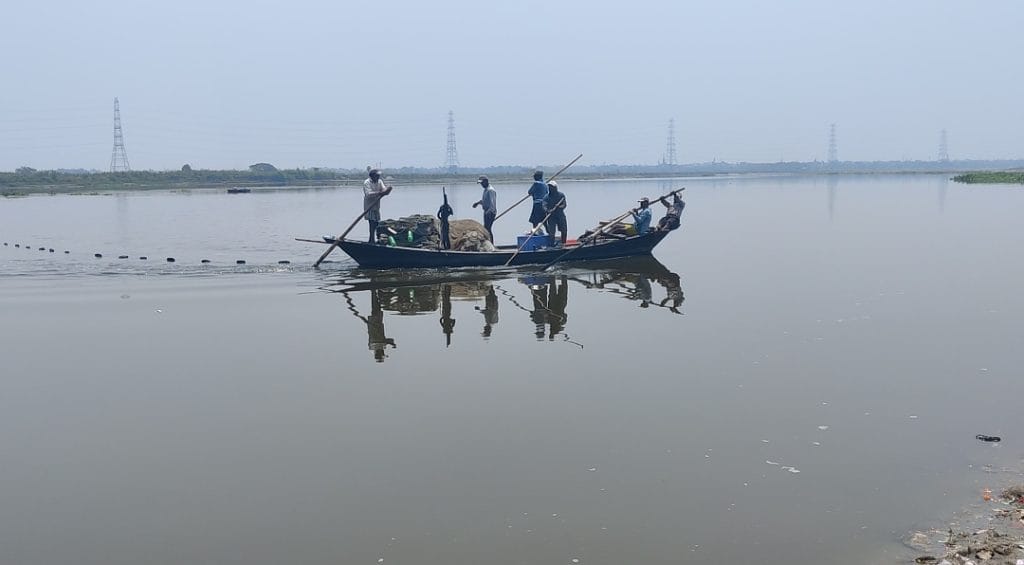
The report also highlighted that the faecal coliform level at Palla, where the Yamuna enters Delhi, was at 1,100 units per 100ml, within the permissible standard of 2,500 units outlined by the Central Pollution Control Board. However, as the river flows through the city, untreated sewage pushes the levels to dangerous highs.
Experts say the Yamuna’s deteriorating condition reflects government inaction and a lack of vision.
“While the Delhi government claims to release treated waste into the river, the alarming levels of pollutants in the river tell a very different story,” said Delhi-based environmentalist Vimlendu Jha, founder of the non-profit Swechha, which has been organising campaigns and creating awareness around the plight of Yamuna.
He added that the pollution in the Yamuna is hazardous to all forms of life, and can cause health problems ranging from skin irritation, watery eyes, and respiratory problems to organ damage and cancer.
“We only start highlighting Yamuna pollution around October and November when it starts frothing. The truth is that the toxins only become more visible around that time because the water level reduces,” Jha said.
Another time the Yamuna invariably becomes a hot topic is during Delhi’s election season.
Also Read: India’s crackdown on old cars faltering—graveyards of vehicles, loopholes in policy
Political rhetoric muddies cleanup
The Yamuna has long been a campaign prop in Delhi elections, with politicians overflowing with promises and blame games. This year is no different.
Home Minister Amit Shah and Uttar Pradesh Chief Minister Yogi Adityanath both dared AAP national convenor Arvind Kejriwal to take his promised dip in the Yamuna, mocking his claim to clean the river within seven years of taking office as Delhi CM.
On his part, Kejriwal this week accused the BJP-led Haryana government of “poisoning” the raw water supply to Delhi, likening it to “biological warfare”. Delhi Chief Minister Atishi too had earlier accused Haryana of deliberately discharging industrial waste into the Yamuna.
Meanwhile, Congress candidate Alka Lamba accused both the BJP and AAP of reducing the river to little more than a “political issue”.
But for activists and residents, the burning question is: Will the Yamuna ever get cleaned, or will it continue to stagnate until the next elections roll around in five years?
The fractiousness on display over the Yamuna during the elections is, in fact, symptomatic of what has led to the clean-up project’s undoing.
The Yamuna rejuvenation project was envisioned as a collaborative effort to bring agencies together for a more focused impact. But while isolated efforts continue—such as desilting drains and connecting slum clusters to sewer lines—activists argue that these are just drops in a river still choking on untreated waste and political inertia.
Experts say the project can only succeed if all stakeholders come together to find a solution. They point out that past initiatives to clean the river have failed due to poor coordination between agencies and a lack of sustained effort. The latest attempt appears to be following the same path.
“Yamuna is like the stepchild of Delhi. Political parties take up its cause only during the election, but when it comes to actually working for it, they want to wash their hands of its responsibility,” said Jha.
(Edited by Asavari Singh)



